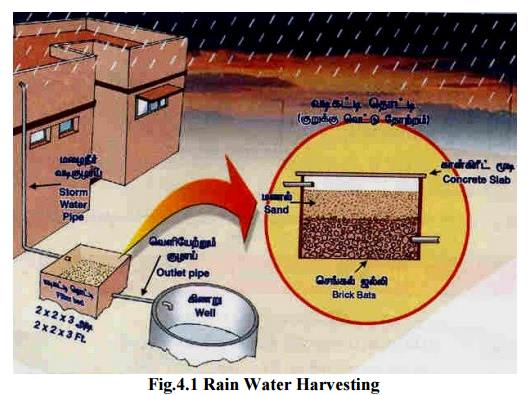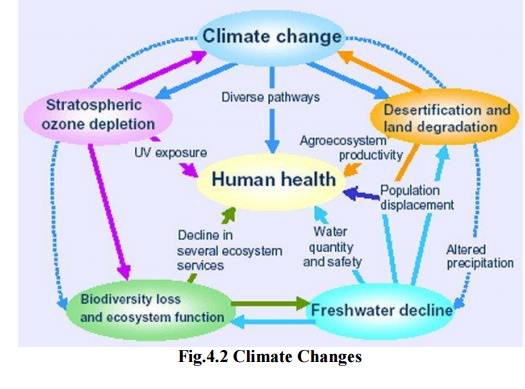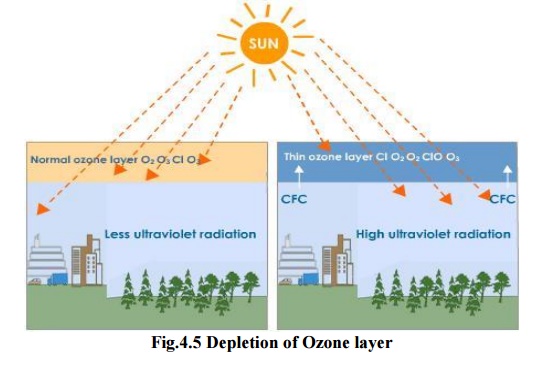Chapter: Environmental Science and Engineering
Social Issues and the Environment
SOCIAL ISSUES AND THE ENVIRONMENT
1 Objectives
Developing
and modernizing the technologies without losing our sound traditional values
and practices is essential.
1.1 Sustainable development
Meeting
the needs of the present, without compromising the ability of future
generations, to meet their own needs.
1.2 True sustainable development
Optimum
use of natural resources with high degree of reusability, minimum wastage,
least generation of toxic byproducts and maximum productivity.
1.3 Dimensions of sustainable development
Multi
dimensional concept – derived from interactions between society, economy and
environment.
1.4 Aspects of sustainable development
Ø Inter-generational
equity
Ø Intra-generational
equity.
1.5 Approaches for sustainable development
·
Developing appropriate technology - locally
adaptable, eco-friendly, resource efficient and culturally suitable.
·
Reduce, reuse, recycle [3R] approach – reduces
waste generation and pollution
·
Providing environmental education and awareness –
changing attitude of the people
v Consumption
of renewable resources – attain sustainability
v Conservation
of non renewable resources – conserved by recycling and reusing
v Population
control.
1.6 Urban problems related to energy
Ø Energy
demanding activities
Ø Solution
for urban energy problem.
2 WATER CONSERVATION
The
process of saving water for future utilization.

2.1 Need for water conservation
ü Changes
in environmental factors
ü Better
lifestyles
ü Increase
in population
ü Deforestation
ü Over
exploitation of ground water
ü Agricultural
and industrial activities.
2.2 Strategies of water conservation
Ø Reducing
evaporation losses
Ø Reducing
irrigation losses
Ø Re use of
water
Ø Preventing
of wastage of water
Ø Decreasing
run-off losses
Ø Avoid
discharge of sewage.
2.3 Methods of water conservation
Rain
water harvesting- A technique of capturing and storing of rain water for
further utilization.
2.4 Objectives of rain water harvesting
v Increasing
demands
v Recharging
the ground water
v Reducing
the ground water
v Increase
in hydro static pressure.
3 WATER SHED MANAGEMENT
– The management of rainfall and
resultant run-off.
3.1 Objectives
To
minimize of risk of floods
![]()
For
improving the economy
![]() For developmental activities
For developmental activities
![]() To generate huge employment
opportunities
To generate huge employment
opportunities
![]() To promote forestry
To promote forestry
![]() To protect soil from erosion.
To protect soil from erosion.
![]()
3.2
Factors affecting watershed o Unplanned land use o Deforestation
o
Droughty climates.
4 RESETTLEMENT AND REHABILITATION OF PEOPLE
4.1 Causes
·
Due to Developmental activities
·
Due to Disaster
·
Due to conservation initiatives.
4.2 Rehabilitation issues
ü Displacement
of tribal’s increases poverty
ü Breakup
of families
ü Communal
ownership of property
ü Vanishing
social and cultural activities
ü Loss of
identity between the people.
4.3 Case Studies
Sardar
Sarovar Dam, the Theri dam Project, Pong Dam.
4.4 Environmental ethics
Refers to
the issues, principles and guidelines relating to human interactions with their
environment.
4.5 Environmental problems
v Deforestation
v Population
growth
v Pollution
due to effluent and smoke
v Water
scarcity
v Land
degradation.
4.6 Solutions
Ø Reducing
the energy sources
Ø Recycle
and reuse of waste products
Ø Soil
degradation
Ø Sustainable
development
Ø Protection
of Bio – diversity
Ø Reducing
the population.
5 CLIMATE
The
average weather of an area.
5.1 Causes of climate change
v Presence
of green house gases
v Depletion
of ozone gases.
5.2 Effect of climate change
·
Migration of animals
·
Upsetting the hydrological cycles results in floods
and droughts
·
Changes in global pattern of winds.

5.3 Green house effect
The
progressive warming of earth surface due to blanketing effect of man made CO2
in the atmosphere.
Green
house gases- causing global warming
CO2,
CH4, N2O, CFCs.

5.4 Effect on global warming
·
Sea level
·
Agriculture and forestry
·
Water resources
·
Terrestrial ecosystems
·
Human health.
5.5 Measures
v Reducing
CO2 emission
v Utilizing
renewable resources
v Plant
more trees
v Adopt
sustainable agriculture.
6 ACID RAIN
The
precipitation of CO2, SO2, and NO2 gases as
pollutants in water.

6.1 Effects of acid rain
1. Human beings
·
Destroy life – nervous, respiratory and digestive
system
·
Causes premature death from heart and lung
disorders.
2. On Buildings
Corrosion
- Taj Mahal, houses, statues, bridges, metals.
3. On terrestrial and Lake Ecosystem
Ø Reduces
rate of photosynthesis, growth of crops, Fish population.
Ø And bio
mass production.
6.2 Control measures
ü Clean
combustion technologies
ü Using
pollution control equipments
ü Replacement
of coal by natural gas
ü Liming of
lakes and soils.
7 OZONE LAYER DEPLETION
Ozone is
formed in the stratosphere by photo - chemical reaction.

7.1 Ozone depleting chemicals
Chloro
Fluro carbon, Hydro chloro fluoro carbon, Bromo fluoroCarbon.
7.2 Effects
v On human
health – Skin cancer, cataracts, allergies etc.
v On
aquatic systems- phyto plankton, fish
v On
materials- paints, plastics
v On
climate – increasing the average temperature of the earth surface.

7.3 Control Measures
·
Replacing CFCs
·
Use of methyl bromide – crop fumigant.
8 NUCLEAR ACCIDENTS AND HOLOCAUST
The
release of large amounts of nuclear energy and radioactive products into the
atmosphere. Nuclear energy was researched by man as an alternate source of
energy compared to fossil
fuels.
Although this did happen along with the benefits came its downfall. In the
short history of nuclear energy there has been a number of accidents that have
surpassed any natural calamity. A single nuclear accident causes loss of life,
long term illness and destruction of property on a large scale.
Examples
1.THE CARELESS SITING OF INDUSTRIES- Bhopal gas
tragedy
The careless siting of industries and relatively poor regulatory
controls leads to ill health in the.The Bhopal gas tragedy on December 2nd
1984, where Union Carbide's Plant leaked 43 tons of Methyl Isocynate and other
substances, used in the manufacture of pesticides is one of the worst
industrial accidents in the recent past. Of the 5,20,000 people who were
exposed to the gas - 8,000 died during the first week and another 8,000 later.
The impact of the survivors is visible even today.

2. CHERNOBYL REACTOR INCIDENT
On April
25, 1986, Russian engineers and scientists begin preliminary tests on Chernobyl
power plant's 4th reactor. In order to control the experiment, the automatic
control system was shut down. After some work, stability was reached at very
low power outputs. Unfortunately, manual control of the water pressure wasn't
maintained. The reactor began to create excess heat. Without the automatic
control, the control rods couldn't be reinserted in time; a deadly chain
reaction had begun. Within a matter of 3-4 seconds, the reactor went from 5%
output to 100 times its normal level. The water in the reactor flash-boiled,
creating an explosion that leveled thousands of tons of concrete and steel,
including the housing for the reactor. The steam carried almost 70% of the
nuclear material out of the reactor into the surrounding environment. Several
thousand volunteers died on the scene, and it is estimated that 7,000 to 10,000
volunteers died in total, considering short and long-term effects. Thousands of
miles from the scene, the birth defect rate became double the world average. It
is also estimated that 150,000 were put at risk for thyroid cancer, and over
800,000 children were put at risk of
contracting leukemia. 2 million acres of land (1/5 of the usable
farmland in the Ukraine) was, and still is, completely unusable. It remains
difficult to determine the scope of the disaster; radiation resulting from the
event was detected all over the globe. It is estimated that it may cost up to
$400 billion and will take up to 200 years to correct the damage done to the
area, and to compensate those affected by the meltdown.

8.1 Effects
Ø Nuclear
winter
Ø Ignition
of all combustible material

8.2 Control Measures
Ø Suitable
precautions to avoid accident
Ø Constant
monitoring of the radiation level
Ø Checks
and control measures done by Atomic Energy Regulatory Board.
9 WASTE LAND RECLAMATION
Waste
land: - The land which is not in use – unproductive, unfit for cultivation
another economic uses.
9.1Types of waste land
1. Uncultivable waste land
– Barren
rocky areas, hilly slopes, sandy deserts.
2. Cultivable waste land
- degraded
forest lands, gullied lands. Marsh lands, saline land etc.
9.2 Causes for waste land formation
v Soil
Erosion, Deforestation, Water logging, Salinity.
v Excessive
use of pesticides.
v Construction
of dams.
v Over-exploitation
of natural resources.
v Sewage
and industrial wastes.
v Mining
v Growing
demands for fuel, fodder wood and food causes degradation and loss of soil
productivity.
9.3 Objectives of waste land reclamation
·
To improve the physical structure and quality of
the soil
·
To prevent soil erosion
·
To avoid over – exploitation of natural resources
·
To conserve the biological resources.
9.4 Methods of waste land reclamation
ü Drainage
ü Leaching
ü Irrigation
practices
ü Green
manures and bio fertilizers
ü Application
of Gypsum
ü Afforestation
programmes
ü Social
forestry programmes.
9.5 Consumerisation of Waste products
·
Consumerisation – Consumption of resources.
·
Traditionally favorable rights of sellers
·
Right to introduce product, price, Incentives
·
Traditionally buyer rights
·
Right to buy, right to expect the product to
perform as claimed
9.6 Important information to be known by buyers
Ø About
ingredients,
Ø Manufacturing
dates,
Ø Expiry
date, etc.
9.7 Objectives of Consumerisation
Improves
rights and power of the buyers
![]() Making the manufacturer liable
Making the manufacturer liable
![]() Reuse and recycle the product
Reuse and recycle the product
![]() Reclaiming useful parts
Reclaiming useful parts
![]() Reusable packing materials
Reusable packing materials
![]()
Health
and happiness.
![]()
10 SOURCES OF WASTES
Glass,
papers, garbage’s, food waste, automobile waste, dead animals etc.
10.1 E – Waste
Computers,
printers, mobile phones, Xerox machines, calculators etc.
10.2 Effects of wastes
o Dangerous
to human life
o Degrade
soil
o Cadmium in
chips, Cathode ray tube, PVC causes cancer and other respiratory problems.
o
Non biodegradable plastics reduce toxic gases.
10.3Factors affecting consumerisation and generation of
wastes
ü People
over – Population
ü Consumption
over – Population.
4.11
ENVIRONMENTAL
LEGISLATION AND LAWS – IMPORTANT PROTECTION ACTS
v Water Act 1974, 1978- An Act
to provide for the levy and collection of water consumed by persons carrying on certain industries and by local
authorities, with a view to augment the resources of the Central Board and the
State Boards for the prevention and control of water pollution constituted
under the Water (Prevention and Control of Pollution) Act, 1974.
v Water amendment Act 1987- As a result, some of the basic principles of water law applicable today in India derive from irrigation acts. The early Northern India Canal and Drainage Act, 1873 sought, for instance, to regulate irrigation, navigation and drainage in Northern India.
o
One of the long-term implications of this act was
the introduction of the right of the Government to ‘use and control for public
purposes the water of all rivers and streams
flowing
in natural channels, and of all lakes. The 1873 act refrained from asserting
state ownership over surface waters. Nevertheless, this act is a milestone
since it asserted the right of the Government to control water use for the
benefit of the broader public.
o
This was progressively strengthened. Thus, the
Madhya Pradesh Irrigation Act, 1931 went much further and asserted direct state
control over water: ‘All rights in the water of any river, natural stream or
natural drainage channel, natural lake or other natural collection of water
shall vest in the Government.
v Air Act 1981- An Act to provide for the
prevention, control and abatement of air
pollution, for the establishment, with a view to carrying out the aforesaid
purposes, of Boards, for conferring on and assigning to such Boards powers and
functions relating thereto and for matters connected therewith.
§ Whereas
decisions were taken at the United Nations Conference on the Hum an Environment
held in Stockholm in June, 1972, in which India participated, to take
appropriate steps for the preservation of the natural resources of the earth
which, among other things, include the preservation of the quality of air and
control of air pollution; and whereas it is considered necessary to implement
the decisions aforesaid in so far as they relate to the preservation of the
quality of air and control of air pollution;
§ Be it
enacted by Parliament in the Thirty-second Year of the Republic of India
v Wild life Act 1972-It refers
to a sweeping package of legislation enacted in 1972 by the Government of
India. Before 1972, India only had five designated national parks. Among other reforms, the Act
established schedules of protected plant and animal species; hunting or
harvesting these species was largely outlawed. The Act provides for the
protection of wild animals, birds and plants; and for matters connected
therewith or ancillary or incidental thereto. Formalization of national parks, wildlife sanctuaries, conservation reserves and
community reserves. Protection to habitat and wildlife within premises of such
protected areas. Development of National Board for Wildlife and State Boards
for Wildlife for identification of future protected areas. Up to April 2010
there have been 16 convictions under this act relating to the death of tigers.
v Forest Act 1980 and Environment Act 1972-
Environment protection act 1986 (23 May
1986) I- it is a legislation which signifies the central government
determination to
take
effective steps to protect the environment.
Stating
that: No State Government or other authority shall make any order directing-
(i) that any
reserved forest shall cease to be reserved;
(ii) that any
forest land or any portion thereof may be used for any non-forest purpose;
(iii) that any
forest land or any portion thereof may be assigned by way of lease or otherwise
to any private person or to any authority, corporation, agency or any other
organization not owned, managed or controlled by Government;
(iv)that any
forest land or any portion thereof may be cleared of trees which have grown
naturally in that land or portion, for the purpose of using it for
reafforestat.
12 ISSUES INVOLVED IN ENFORCEMENT OF ENVIRONMENTAL LEGISLATION
·
Drawbacks of wildlife protection Act
·
Drawbacks of Forest Act 1980 and
·
Drawbacks of Environment Act 1972.
13 PUBLIC AWARENESS
Our
environment is presently degrading due to many activities like pollution,
deforestation, overgrazing, rapid industrialization and urbanization.
13.1 Objectives of public awareness
Create
awareness among people of rural and city about ecological imbalances, local
environment, technological development and various development plants.
To
organize meetings, group discussion on development, tree plantation programmes
exhibitions.
To learn
to live simple and eco-friendlily manner.
13.2 Methods to create environmental awareness
ü In
schools and colleges
ü Through
mass – media
ü Cinema
ü Newspapers
ü Audio -
Visual media
ü Voluntary
organizations
ü Traditional
techniques
ü Arranging
competitions
ü Leaders
appeal
ü Non –
government organizations.
Related Topics